Satellite Tracking Project (LEO)
What we are deploying:
- ICOM IC 910H
- M2 LEO-pack which has a 2MCP8A (143-148 MHZ) and a 436CP16 (432-440 MHZ)
- AlfaSpid RAS (AZ/EL) Rotator and Alfa ROT2Prog Controller
19 Jun 2019 – We left the controller on for a week to see if there was any slippage or other obvious issues with the rotator. Fortunately, everything seems to be working fine. After conferring with Sawson, KG6NUB, who helped us with all the preliminary work (see the bottom of this page), he had a few follow-up recommendations inluding rotating our elements 45 degrees. He mentioned this will help keep water from rain and humidity from settling on the elements affecting SWR. Today, we (Kevin and John) lowered the mast to do an inspection, rotate the antennas, replaced some velcro with Super 88 tape, and pre-wound some of the cable around the mast. We are going to wait a little longer and see how the cables are before deciding on how and where to attach the cable above the antenna below the LEO. Also, we moved the cam a little further back yesterday so it is over the edge of the penthouse to try to get a better field of view of the antenna … and the Golden Gate Bridge in the distance 😉
10 Jun 2019 – John Yang was nice enough to help us raise the mast. Miki and Kevin are in the third photo. After these photos were taken, Kevin and Miki were able to track a satellite and listen to some transmissions (update: they heard CW and SSB from FO-29) Yay! We are now conducting more extensive tests of the rotator and configuring the software on the PC in the shack. We will be monitoring the installation over the next few weeks to see if there are any physical problems.


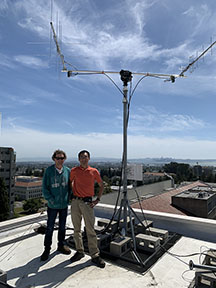



7 Jun 2019 – After several more tests of all the components, we decided to assemble everything (antennas were assembled last semester) and raise the mast. Here is Kevin attaching the rotator to the mast in the first photo and the 2M antenna to the crossbar in the second photo. The third photo is with everything attached. It was already getting late so we decided to stop and do a final check on monday before raising the mast.
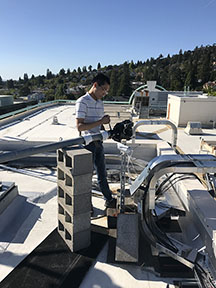


14-24 May 2019 – The controller came back on monday. Unfortunately, there were a few little issues. First, we had to reverse the polarity of power. Apparently, this happens with this particular older model of controller from AlfaSpid. Once we reversed the polarity, the controller came back to life. We’d like to thank Alfa Radio for the patience and help with bringing this controller back to life. In particular, I’d like to thank Amanda for expediting our repairs before they left for Hamvention and Dave Yaeck, VE6DJY, for repairing our controller and for all the help he provided after it was returned. We started installing the trays on the roof of the penthouse (north and south sides of the roof) You can also see the mast on its side. The two white plumbing reducers seen on the mast cover the bolts so the cables won’t snag or become damaged by an exposed bolt.
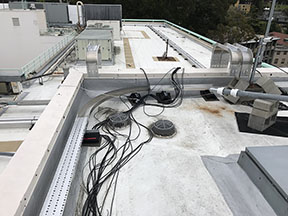
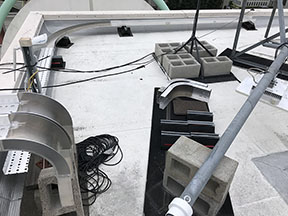
Jack Kolb, KM6ELK, adding a rubber edge protector to the trays.

4-10 May 2019 – Starting today we are going to be pushing to get the LEO up and running. We ordered some missing cables that will allow the PC to talk with the ICOM 910H. We also determined that something happened to the controller and we will need to send it back to Alfa Radio for repair … it probably didn’t help leaving the top off of the controller in a controlled but yet public space. We spent over 10 hours drilling through the mast to insert bolts to hold the inner pipe/mast in place.
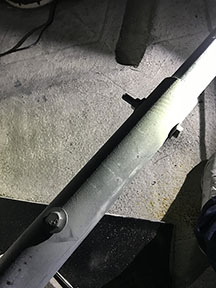
We also attached the cable management trays to the face of the penthouse … still need to clean up some of the cabling 😛
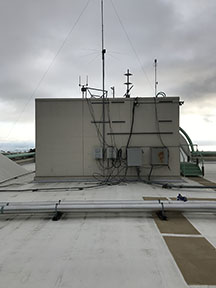
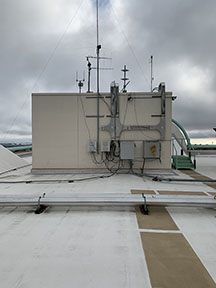
22 Mar 2019 – Sunny all week and Celine strategically selected a rainy day so everyone can go home right away 🙂 but we (Celine and Kevin) were able to test fit the pipe Travis picked up before heading inside to work on the controller.

22 Feb 2019 – Before the rain arrives tomorrow, Sukrit, Celine, and Rafael remove the rotator.
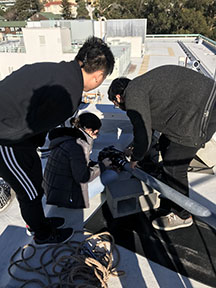
Rafeal, Sukrit, Kevin, and Celine
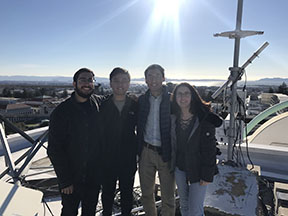
Celine, Rafael, and Sukrit in the shack working on the rotator and rotator controller.
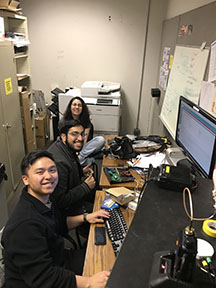
20 Feb 2019 – Kevin and Olivia (Hall is out of frame) trying a home-made coupler which we decided should be sturdier.
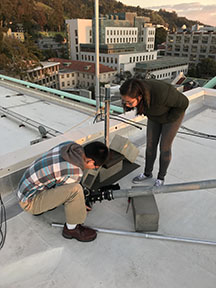
6 Feb 2019 – Kevin and Celine removed the older antennas from the mast and did a test fit of the rotator on the mast. Since the last post, Kevin, Celine, Hall, Neelay, and Aled have assembled both antennas and have tested all the individual components. We have determined one connector on a cable was stressed a bit while it was being pulled through the very full conduit. We are waiting for a replacement connector.
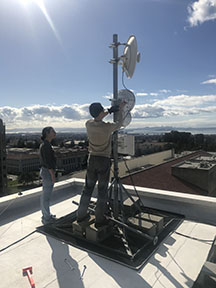
Here is a time-lapse of the removal. We nudged the camera back into place at around 13:17 and finish by 14:00.
12 Oct 2018 – Last friday we were able to arrange some time with Derek to pull the cables the last ten feet. Yay! The issue was the size of the conduit. It carried three bundles of fiber up to the roof but they were in those stiff plastic protective tubing. In the picture, you can see two of the three with the third hiding behind them. Side note, Metricom with their Ricochet modems were one of the first companies to offer cellular data services at the start of the internet boom. If you are ever on the roof of Cory Hall, the conduit that runs along the perimeter were used for their antennas.
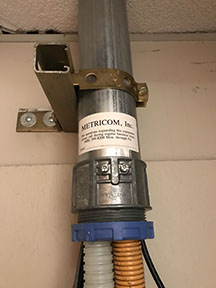
As you can see there was no space to pull additional cables through it. Derek allowed us to decommission a set so we could pull the cables through. Derek is a bit shy.

The original run just punched a hole through the wall … violating a few rules and irking a few of us regarding proper strain relief on cables.
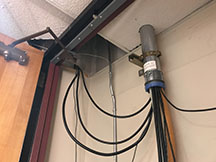
Now, there is a proper fire stop and a waterfall for the cables on both sides of the wall.
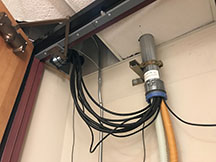
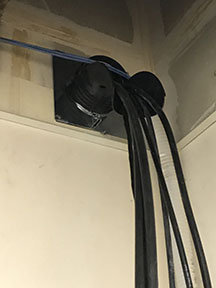
So we’re getting a little closer. Kevin and Hall have been cleaning up the shack and testing various components before the actual deployment.
/update
I met with Hall, Celine, Kevin, and Travis to go over the logistics of the installation.
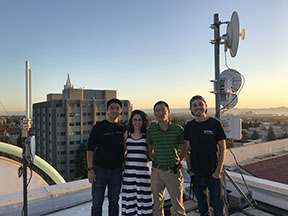
20 Aug 2018 – We pulled the cables through the main part of the run today. Since this is the first week of classes, it may be a few days before we have a chance to finish pulling the last part of the run into the shack.
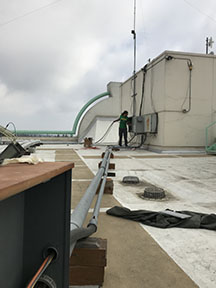
16 Aug 2018 – Everything has arrived and we have tested the rotator and controller. We have made arrangements with Derek to pull cables this week *fingers crossed* and final assembly might be as soon as next week.
A little premature, but I’d like to thank all of the students, especially Kevin, who started this process, and Hall who helped get it over the finish line. I’d also like to thank KG6NUB again for his patience as we slowly made our way to this point and for all of his invaluable guidance and wisdom. I’d also like to thank the people at M2 for their advice, Professor Prabal Dutta who has kindly arranged for cable management to be installed on the penthouse, Scott McNally, Logan Baldini, and Derek Calderon for their advice, guidance, and elbow grease to get this antenna up and running. Finally, a special thanks to Professor Miki Lustig for his guidance and making all of this possible.
6 Aug 2018 – All of the remaining cables and supplies have been ordered by Hall which have started to arrive. We are hoping to receive everything in the next week or two and can hopefully have the antenna up and running right as the semester starts.
2 Jul 2018 – Although we haven’t updated this page recently, we have been working continuously towards installing the hardware.
Location – We have met with and made arrangements with the building and facilities managers to proceed. Besides installing the antenna, Professor Dutta has graciously agreed to fund the installation of cable management trays/runways on the penthouse (Thank you, Prabal!). We have also met with the department network engineer to clean up the existing cabling.
Components – KG6NUB has provided us with many recommendations regarding hardware and cabling. We went with his recommendation and picked up an ICOM IC 910H, KP-2/2M and KP-2/440 Preamps, and an M2 LEO-pack.
Cabling – Besides KG6NUB’s recommendation, we contacted M2, the antenna manufacturer, asking their recommendations about cabling. This is a concern because the run is so long, 130′ from shack to the top of the mast, and we wanted to make sure we crossed our t’s and dotted our i’s before purchasing cabling. Another important concern that KG6NUB brought up and KK6MRI reminded us is the flexibility of the cable. When you are tracking satellites, cables need to be able to endure repeated flexing but the jacket on flexible cables are not as rugged as their non-flexible siblings. Once we finalize the cabling selection, I will update this page.
31 May 2018 – We are still in the process of installing the hardware. Kevin has already sourced all the hardware and we are currently planning the installation. We are hoping to have everything installed before the end of summer *fingers-crossed*
You can always join the Slack Channel!